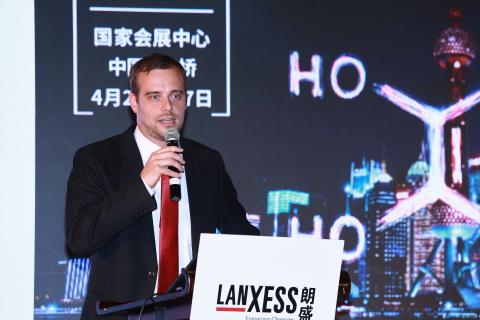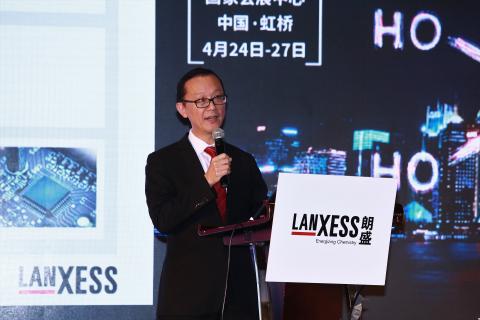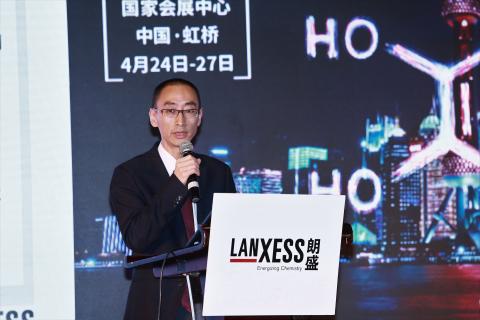- High-tech engineering plastics
- Vehicle lightweight solutions
- Additives with safety and stability
- Bringing color to the world of polymers
April 23, 2018, Shanghai – From April 24 to 27, specialty chemicals company LANXESS will present at Chinaplas 2018 in Shanghai. The theme of LANXESS for the event is “Quality Shapes”. At stand T31, extending over 120 square meters in Hall 7.2, the specialty chemicals company is presenting its latest developments in materials, processes and technologies for premium plastics solutions and high-performance additives. Also on display are color pigments developed for the polymer industry.
“The theme of the exhibition reflects LANXESS’ brand claim of ‘Quality Works’. In short, it means we aim to provide customers with high-performance products, to jointly develop innovation and sustainable application with them and to drive the industry value chain towards the mid-to-high end. In this exhibition, we will focus on China's significant industry trends such as electric cars, green buildings, building safety, environment-friendly and energy-saving manufacturing process and so on, and introduce the latest technology and solutions to local customers," says Ming Cheng Chien, CEO of LANXESS Greater China.

Focus on New Mobility
With the rapid development of new forms of mobility such as autonomous driving, the electrification of vehicle power trains, and new logistics concepts, LANXESS sees a wide application potential of high-tech thermoplastic materials. To meet the growing demands of the Chinese market, LANXESS announced in late 2017 that it is building a new high-performance engineering plastics plant in Changzhou.
LANXESS sees significant potential for the application of its high-tech plastics in lightweight design, charging systems, battery solutions, sensors for autonomous driving and housings of electric motors as well as in the infrastructures of e-mobility, for instance, in charging stations. We have developed dedicated and innovative solutions with our PA6, PA66 & PBT polyamides to tackle the challenges and innovate for e-mobility and autonomous driving,” says Michael Rockel, Head of Greater China Sales & Marketing of LANXESS’ High Performance Materials business unit.
Another hot topic at LANXESS is the new PA66 type XTS2 (Extreme Temperature Stabilization). It increases the thermal stability of polyamide 66 to up to 230 °C. Important mechanical properties – such as tensile modulus, breaking stress or IZOD impact strength – are maintained at a high level even at constant temperatures of up to 230 °C. Unlike many other thermostabilization options, the new system shows no stabilization gap between 160 °C and 230 °C. XTS2 materials have their target applications in vehicles with efficient combustion engines. The first product from the XTS2 portfolio is a polyamide 66 reinforced by 35% glass fiber, which is marketed as Durethan AKV35XTS2. It is ideal for the production of components such as air intake manifolds with an integrated intercooler. Another polyamide 66 with a 30% glass fiber reinforcement is under development, which is used for blow molded hollow components such as air ducts in the engine compartment. The high temperature stabilization is also available for PA6 based materials, that allows the replacement of current PA66 based solutions which are under enormous cost challenges due to limited material availability in these days.
Environmentally friendly lightweight solutions for the automotive industry
In the display area, LANXESS is showing a series of innovative, resource-saving and environmentally friendly lightweight solutions. Depending on the requirements for the application in question, engineering plastics can entirely replace comparatively heavy metal parts or be combined with composite materials (such as the LANXESS Tepex product range). The weight of individual components can be reduced by using lightweight materials and technologies, without compromising on their physical properties, such as mechanical strength.
As one of many examples of lightweight applications, LANXESS will be exhibiting an oil pan module made of Durethan BKV 30 H2.0 (PA 6) for the Porsche 911 Carrera. This is a highly sophisticated component satisfying all the specific requirements imposed on the new-generation engine in terms of weight reduction, function integration and cost-efficient production and despite the industry standard is now designed in PA6 and not the traditional PA66 material. LANXESS is looking forward to further share details on this application at our stand with you.
At this exhibition, another focal topic of the LANXESS presence lies in the continuous-fiber-reinforced thermoplastic composites of the Tepex brand family. They are becoming increasingly important for lightweight vehicle design and can be found today in increasing number of series production applications – for example, front-end mountings, underfloor protection and bumper beams, brake pedals, through-loading systems, and fuel tank reinforcements. There are also significant potentials for use in vehicle underbodies, for the protection of batteries and in new concepts for highly-integrated, multi-position seats.. LANXESS is currently developing composite variants with electromagnetic shielding properties, especially for components of electrified vehicle drivetrains.
Tepex can also be used to fabricate virtually indestructible engine compartment trims, fuel tank covers and center tunnel covers, which already in use in several standard models. These continuous-fiber-reinforced thermoplastic composites likewise are suitable for manufacturing very stiff, strong, thin-walled components, such as device mounts with high functional integration, versions of which are already in use in several standard models.
Products for sports equipment, such as soccer shoes, ski boots, bicycle parts and golf club components, are displayed as well. They likewise benefit from the significant weight advantages of this modern lightweight material.

Additives with safety and stability
LANXESS’s Additives business unit is also showcasing products from its extensive line of additives. With successful acquisition of former Chemtura in 2017, LANXESS has become one of the world's leading suppliers of flame-retardant additives.
LANXESS expects that an annual average growth rate of 4% will be achieved in the mid-term market of flame-retardant additives. "The development trend of energy-efficient buildings promotes the rising demands for flame retardants. At present, we are able to provide customers with series of complementary bromine and phosphorus-based products from a single source. With outstanding performance, these materials are widely used in various fields of construction industry. In addition, our strong setup and global presence of technical competence centers including Nanjing and Qingdao laboratories offer solution and value added services to customers in China and other Asia countries,” says Hak Leong Chok, Executive Vice President of LANXESS Additives business unit, Asia Pacific.
LANXESS’s Additives business unit will exhibit its halogen-free phosphorous flame retardant and hydrolysis stabilizers. Levagard TP LXS 51114 is a low-emission flame retardant that is excellently suited to use in polyether and polyester polyurethane (PU) flexible foams, e.g. in automotive interiors. The product can also serve as a flame-retardant plasticizer in cellulose derivatives, particularly cellulose triacetate (CTA), showing great value in manufacturing housings for electronic devices. The halogen-free phosphoric acid ester Disflamoll 51092 has a low odor and can be used in many plastics (plasticized PVC, flexible PU foams, TPU, PC-ABS and NBR-PVC blends).
Stabaxol P 110, a hydrolysis stabilizer for plastics and polyurethanes, is the first product in a new line of innovative, low-emission polymeric carbodiimides based on alternative raw materials. It shows outstanding performance when used in the thermoplastics PET and in thermoplastic elastomers (TPE-E). Above all, in the bioplastic polylactic acid, it significantly extends the service life of the final article under moist and warm operating conditions.

Bringing color to the world of polymers
Colored plastics are becoming increasingly popular and the range of applications is expanding continuously. However, the pigments must satisfy a number of exacting requirements. Given the short dwell time and relatively low shear force in customer processes, they must display good dispersibility, i.e. they must be easy to disperse so as to reach their final tinting strength quickly. They must display high thermal stability, no migration and sufficient levels of light fastness and weather fastness for the intended application. Colortherm iron and chromium oxide pigments from LANXESS’s Inorganic Pigments business unit meet these requirements in full. What’s more, they are easy to process and their special micronization allows for high throughput, because the very finely ground pigments disperse quickly in a plastic. The U.S. Food and Drug Administration (FDA) has recognized the environmental-friendly and safe pigments from the Colortherm range as a raw material for coloring toys and food packaging.
LANXESS has always been committed to environmental responsibility, efficiency and quality. On February 24, 2018, LANXESS’s inorganic pigment plant in Ningbo was successfully included into the list of the second batch of green plants issued by the Ministry of Industry and Information Technology. With "Ningbo Process" developed in the Ningbo plant, the energy consumption can be reduced by 80% in the production process of iron oxide red pigment, and by-products produced can be recycled. For example, carbon dioxide equivalent in the production process is reduced greatly; nitrous oxide is converted into natural air and water with special catalysts, etc.




